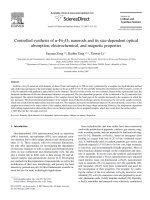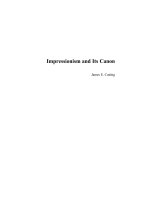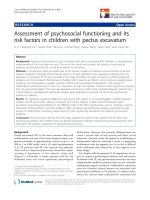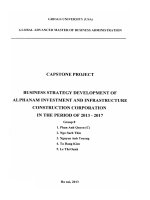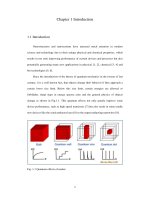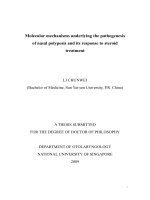The cult of guangze zunwang and its religious network in the chinese diaspora, 19th century 2009
Bạn đang xem bản rút gọn của tài liệu. Xem và tải ngay bản đầy đủ của tài liệu tại đây (4.38 MB, 133 trang )
SACRED TIES ACROSS THE SEAS:
THE CULT OF GUANGZE ZUNWANG AND ITS
RELIGIOUS NETWORK IN THE CHINESE DIASPORA,
19TH CENTURY—2009
CHIA MENG TAT JACK
(B.A. (Hons.), NUS)
A THESIS SUBMITTED
FOR THE DEGREE OF MASTER OF ARTS
DEPARTMENT OF HISTORY
NATIONAL UNIVERSITY OF SINGAPORE
2009
ii
Acknowledgements
Truly, those who are good people are thankful and grateful.
Vinaya IV 55
Many people and institutions have assisted me in the course of writing this thesis, and I
am truly grateful to all of them. First of all, I wish to thank my advisor, Assoc Prof
Huang Jianli, for his guidance, fatherly concern, and for reading the earlier drafts and
making many insightful suggestions. I am grateful to Assoc Prof Thomas DuBois for his
encouragement, friendship, and sound advice throughout my education at the National
University of Singapore (NUS). I give my heartfelt thanks to Dr Quek Ser Hwee for her
constant encouragement and helpful guidance. Many teachers have taught me over the
past few years, but a few do deserve special mention: Barbara Andaya, Tim Barnard,
Beatrice Chong, Ian Gordon, Hong Lysa, Bruce Lockhart, Shelley Low, Tony Reid, Sai
Siew Min, and Yang Bin. They have taught me what it takes to be a good history teacher.
I am very grateful to the administrative staff and graduate community at the
Department of History for making my two years of graduate studies so fun and enjoyable.
Kelly Lau, our friendly graduate secretary, has provided me with a great deal of
assistance and helpful advice. Guo Jingyu, Hu Wen, Edgar Liao, Liu Guoyi, Ng Eng Ping,
Pang Yang Huei, Robin Chee, Shu Shengqi, Wang Luman, Wei Bingbing, Yang Shaoyun,
Yang Zhiqiang, Jackie Yoong, and Zhang Jing, are just few of the many who have
constantly helped and supported me. I am also grateful to Loh Kah Seng for his constant
encouragement and practical advice. Special thanks to Mok Mei Feng for her friendship
and for everything she has done for me.
My research in China, Malaysia, and Singapore was made possible with the kind
assistance and support of several friends and informants. Prof Huang Guosheng, Pan
iii
Rongyang, and Zhou Tingting from Fujian Normal University were great hosts during
my stay in Nan’an. Wu Cuirong, the Director of Quanzhou Museum of Overseas Chinese
History, had greatly facilitated my access to the museum library. Much appreciation is
due to Tim Yap Fuan and other staff at the NUS Central Library and Chinese Library for
their kind assistance. I am especially grateful to Chen Zhonghe of Shishan Fengshan Si,
Cheah Chay Tiong of Shanyun Gong, and Tan Aik Hock of Singapore Hong San See, for
providing me with important information, contacts, and granting me access to invaluable
research materials. I must also thank Huang Shiqun, H. T. Lau, Li Tianxi, Helen Low, Lü
Mingcong, Ronni Pinsler, Yeo Cheng Hee, Victor Yue, Zhao Wanchao, and Zhou Xinjia,
for their readiness and patience in answering my endless queries. Needless to say, all
errors and inaccuracies remain my sole responsibility.
Portions of this thesis have been presented at the “20th Conference of the
International Association of Historians of Asia” at Jawaharlal Nehru University and
“Pacific Worlds in Motion II: An Interdisciplinary Conference on Asian Migrations” at
NUS. I am grateful to Prof Henry Yu and the participants in each of these conferences for
their helpful comments.
My deepest and most heartfelt gratitude goes to my friends for their love and
support. I am grateful to Soh Gek Han for her tireless help and support, and above all, for
taking time off from her busy schedule to proofread my work. Gina Phang, my dear
friend and buddy, for her encouragement and concern. I thank my Dharma teachers and
friends, Bhante Dhammika, Ven. Kwang Phing, Yamizi Quek, Richmond Tan, and Yap
Ching Wi, for keeping me in their prayers. I am also grateful to my friends from
iv
Sociology Society 2004/05, in particular Johan, Jono, Mindy, Shah, Shuli, and Weijing,
for always being there for me, and making my life in NUS more fun and meaningful.
I am most grateful to my family for providing me with emotional and financial
support throughout my years of education—my grandmother, to whom this thesis is
dedicated, for first introducing me to Chinese religion; Mum and Dad, for believing in me
and supporting my decision to pursue an academic career; and Melissa, for her endless
love and understanding.
Finally, to Buddha, for His boundless grace and compassion.
Chia Meng Tat Jack
November 8, 2009
v
Table of Contents
Acknowledgements
ii
Summary
vii
List of Illustrations
ix
Note on Conventions
x
Introduction
Dealing with Issues Pertaining to the Cult of Guangze Zunwang
Grafting a Religious Dimension onto Chinese Diasporic Studies
Research Methodology and Sources
Chapter Overview
1
2
6
17
19
Chapter 1
Background: Chinese Migratory Flow from Nan’an and
Settlements in Singapore and Malaya
Chinese Migration and the Nan’an Migrants
Migratory Flow into Singapore and Malaya
Nan’an Settlements in Singapore and Malaya
Chinese Migration and Religious Transplantation
22
Chapter 2
Incense from Southeast China:
Early Temple Building and Pre-1949 Religious Network
Who is Guangze Zunwang?
Early Temple Building in Singapore and Malaya
Temples, Communal Integration, and Social Welfare
Religious Network in the Chinese Diaspora
35
Chapter 3
Turbulence: Distancing, Disruption, and Reconnections in
Diasporic Religious Network, 1949-1978
The Distancing: 1949 Divide and the Malayan Emergency
Disruption of Diasporic Network: The Cultural Revolution, 1966-1976
Establishment of New Temples in the Period of Distancing and Disruption
Setting the Context for Religious Reconnections
58
22
25
28
32
35
43
50
53
59
63
67
72
vi
Chapter 4
Recent Quest for Religious Roots:
Temple Network, Pilgrimages, and Inter-Temple Rivalries, 1978-2009
Rebuilding of Shishan Fengshan Si and Resurgence of Religious Network
Pilgrimages and Religious Exchanges
Religious Competition and Inter-Temple Rivalries
75
Conclusion: Sacred Ties across the Seas
97
Character Glossary
102
Bibliography
108
Appendix A
Brief Biographies of Informants
119
Appendix B
Paintings Depicting the Life of Guangze Zunwang
121
76
84
91
vii
Summary
Large scale Chinese emigration began in the mid-nineteenth century and lasted through
the first half of twentieth century. Since the early nineteenth century, there were many
instances of Nan’an people leaving their homeland and migrating to different parts of
Southeast Asia. The migration of the Nan’an people contributed to the spread of Guangze
Zunwang’s cult from Southeast China to Southeast Asia in general, and Singapore and
Malaysia in particular. Following the arrival and settlement of the Nan’an migrants, the
need for spiritual and emotional support, as well as a permanent place of worship,
prompted the establishment of Guangze Zunwang temples in the two host countries.
This study examines the cult of Guangze Zunwang and its religious network
connecting Southeast China and the Chinese communities in Singapore and Malaysia as
they overlap with the larger forces of migration and socio-political changes, over the
course of two centuries, from the early nineteenth century to 2009. It argues that the
diasporic religious network of the Guangze Zunwang’s cult has a significant role in the
trans-regional movement of resources—including knowledge, money, and people—
between China and the Chinese overseas. As this research will illustrate, temples were
important institutions for the Chinese diaspora, in which they served as important nodes
in this diasporic network.
The changes to the Guangze Zunwang religious network took place against a
wider socio-political backdrop of multiple events, including the mass Chinese migration,
religious dispersion, Sino-Japanese War, Malayan Emergency, Cultural Revolution, and
the reform and opening of China. This study has divided such developments into the
three broad phases of formation, disruption, and revival. The first phase, from the
viii
nineteenth century to the pre-1949 period, marked the creation of this diasporic religious
network. It began with the mass Chinese migration and the arrival of Nan’an migrants to
Singapore and Malaysia. This was quickly followed by the spread of the cult of Guangze
Zunwang and establishment of temples in the host countries. The years from 1949 to
1978 constituted the second phase of the cult’s diasporic network. These three decades
began with the dramatic distancing, and subsequently the disruption of religious ties and
traumatic destruction of the cult in China. The final phase of the diasporic religious
network, from 1978 onwards, was ushered in with the end of the Cultural Revolution,
introduction of a Reform and Open-Door Policy, and gradual liberalization of religious
policy in China. The rebuilding of Shishan Fengshan Si and the revival of religious
network once again made possible the trans-regional movement of resources. This
research concludes that the significance of diasporic religious networks can by no means
be underestimated.
ix
List of Illustrations
Maps
1.
Nan’an in present-day Fujian, China
23
2.
Initial residential concentration of early Nan’an migrants in Singapore,
circa nineteenth century
29
3.
Initial residential concentration of early Nan’an migrants in Malaya,
circa nineteenth century
31
Figures
1.
Images of Guangze Zunwang and Zunfei
37
2.
Shishan Fengshan Si
42
3.
The Global Spread of Guangze Zunwang’s Cult
44
4.
Singapore Hong San See
45
5.
Kuching Hong San Si
48
6.
Qilinling Fengshan Si
48
7.
Chen Xijing
62
8.
Beheaded immortal carvings on the temple pillars at Weizhen Miao
65
9.
Wu Hongye
77
10.
Shishan Fengshan Si in present-day Nan’an, China
81
11.
Taiwang Ling
83
12.
Longshan Gong
83
13.
Pilgrims from Papar Tengnan Tang and Yabi Binan Tang of Sabah,
Malaysia
85
14.
Director Huang Shiqun presenting a plaque to Chen Yinglai, the Chairman
of Singapore Hong San See
91
Diagrams
1.
The Guangze Zunwang religious network between China and the overseas
temples since the 1980s
92
x
Note on Conventions
This thesis uses the pinyin system to romanize Chinese names and terms. However, for
reasons of familiarity, certain names and terms (eg. Hong San See) are romanized
according to the original spelling that appeared in the sources. When the first character of
a name denotes a place, the more familiar local English translation is used. Thus, Baba
Tengnan Tang is rendered as “Papar Tengnan Tang” and Zhangyi Fengshan Si is
rendered as “Changi Fengshan Si.” A list of romanized names and terms and their
corresponding Chinese characters is provided in the character glossary at the end of this
thesis.
China and the People’s Republic of China (PRC) are used interchangeably to
describe the Chinese mainland since 1949. Malaya achieved its independence in August
1957 and the Federation of Malaysia was established in September 1963. In most cases, I
have used the term “Malaya” for the pre-1963 period and “Malaysia” for the period since
1963. In some instances, however, I have preferred to use the term “Malaysia” in my
discussions when I refer to this Southeast Asian country over the course of two centuries.
1
Introduction
Each year, on the twenty-second day of the second and eighth lunar months, devotees of
Guangze Zunwang (The Reverent Lord of Broad Compassion) in Nan’an, throughout the
Quanzhou region, and even all over parts of Hong Kong, Taiwan, and Southeast Asia,
celebrate the birthday and ascension of the deity. The cult, which originated in China
more than a thousand years ago, remains very popular in the present-day among the
Chinese communities in Southeast China and the ethnic Chinese overseas.1 The sacred
legends and stories of miracles and spiritual efficacy associated with the deity have
continued to attract believers from all walks of life. The end of the destructive Cultural
Revolution and relaxation of control over religions in China since 1978, have brought
about a rapid resurgence of Chinese traditions and religious practices. This has not only
allowed the rebuilding and restoration of Guangze Zunwang sacred sites in Southeast
China, but has also contributed to the revitalization of its diasporic religious network
connecting China and the Chinese diaspora.
Over the past two centuries, popular religion in Southeast China and the overseas
Chinese communities have undergone constant political and social changes. What has
remained unbroken, however, is that local cults in general and the cult of Guangze
Zunwang in particular continue to be the bond between the ethnic Chinese overseas and
their ancestral homeland in Southeast China. This study examines the cult of Guangze
Zunwang and its religious network connecting Southeast China and the Chinese
communities in Singapore and Malaysia as they overlap with the larger forces of
1
In this study, I adopt Paul R. Katz’s definition of “cult,” which refers to “a body of men and women who
worship a deity and give of their time, energy, and wealth in order for the worship of this deity to continue
and thrive.” See Paul R. Katz, Demon Hordes and Burning Boats: The Cult of Marshal Wen in Late
Imperial China (Albany: State University of New York Press, 1995), p. 3.
2
migration and socio-political changes, over the course of two centuries, from the early
nineteenth century to 2009. It argues that the diasporic religious network of the Guangze
Zunwang’s cult has a significant role in the trans-regional movement of resources—
including knowledge, money, and people—between China and the Chinese overseas. As
this research will illustrate, temples were important institutions for the Chinese diaspora,
in which they served as important nodes in this diasporic network. My hope is therefore
to offer an understanding of how religion can shed some light on the long-term evolution
of the relations and interactions between China and the Chinese overseas communities.
Dealing with Issues Pertaining to the Cult of Guangze Zunwang
Guangze Zunwang, a popular deity in Southeast China, has received a fair amount of
attention from a number of scholars. The first major study on the cult of Guangze
Zunwang is Keith Stevens’ short article published in 1978. Stevens begins by offering an
estimated number of Guangze Zunwang temples in Hong Kong, Singapore, Malaysia,
and Taiwan. He then provides a brief account of the life and times of the deity, and his
subsequent deification.2 While this article provides a concise and useful narrative of the
background of Guangze Zunwang, it strongly lacks academic analysis, and neither
discusses the spread of the cult nor its existing religious network between China and the
Chinese overseas. Kenneth Dean’s influential monograph examines the history and
practices of three major popular cults in Southeast China, namely Baosheng Dadi (The
Great Emperor Who Protects Lives), Qingshui Zushi (The Patriarch of the Clear Stream),
2
Keith Stevens, “The Saintly Guo (Sheng Gong),” Journal of the Hong Kong Branch of the Royal Asiatic
Society 18 (1978): 193-198.
3
and Guangze Zunwang.3 In his chapter on Guangze Zunwang, Dean discusses a number
of multifaceted issues surrounding the deity, including the prominence of the cult, its
historical sources, the divergent legends of the deity, the history of the temples, the
differences between the Confucian and Taoist interpretation of the deity in two temple
gazetteers, the popular ballads and scriptural innovations, the deity’s self-criticism, and
the co-existence of Confucian and Taoist rituals dedicated to the god.4 As the geographic
focus of Dean’s study is the Minnan “Zhang-Quan” region of Southeast Fujian, the
overseas dimensions as well as the cult’s diasporic religious network are left out in the
discussion.
A number of Chinese language works have began to study the spread of the cult
of Guangze Zunwang and the proliferation of its temples overseas. One such work is by
Li Yukun who looks at the origins and spread of the Guangze Zunwang’s cult. He argues
that the faith facilitates interactions between China and the Chinese overseas, which
promotes peace and harmony. 5 Li suggests that the cult remains highly significant in
Taiwan and Southeast Asia, and he briefly surveys the temples in Taiwan, Singapore, and
Indonesia.6 Zhuo Kehua examines the Guangze Zunwang temple in Lugang, Taiwan. His
article has three aims: first, to discuss the spread of the cult from China to Taiwan;
second, to narrate the history and development of the faith; and finally, to show how the
custom of “celebrating the sixteenth birthday” (zuo shiliusui) is believed to have
3
Kenneth Dean, Taoist Ritual and Popular Cults of Southeast China (Princeton, N.J.: Princeton University
Press, 1993).
4
Ibid., pp. 131-171.
5
Li Yukun, “Guangze Zunwang xinyang jiqi chuanbo” [The belief and spread of the cult of Guang
Zunwang], Shijie Zongjiao Yanjiu [Studies on world religions] 3 (1997): 122.
6
Ibid., p. 126.
4
originated from the cult.7 A third study by Li Tianxi investigates the propagation of
Guangze Zunwang’s cult and its influence among the overseas Chinese. He briefly
surveys the temples in Singapore, Indonesia, Philippines, Malaysia and Thailand, and
argues that the religious belief serves three important functions: first, sentiment towards
the homeland; second, promotion of traditional Chinese culture; and finally, maintaining
close ties between the overseas Chinese and their ancestral place of origin.8 The three
studies are quick to discuss the overseas transmission of the cult and its significance in
facilitating interactions and ties between the Chinese diaspora and China. However, they
simply attribute such interconnectivity to the presence and popularity of the cult, without
considering the existence of any broader diasporic religious network in any form.
Previous literature on the Guangze Zunwang’s cult either neglect the transregional issues surrounding the belief, or overemphasize the spiritual ties without offering
further analysis on the existence of any diasporic religious network. 9 Tan Chee-Beng
(Chen Zhiming) and Wu Cuirong’s book chapter marks a departure from the earlier
studies. Using Shishan Fengshan Si, the ancestral temple of Guangze Zunwang’s cult, as
one of their case studies, Chen and Wu argued that the transnational networks connecting
South China and the Chinese overseas have contributed to the vibrant economic
development in Shishan since the Reform and Open-Door period. 10 While their brief
7
Zhuo Kehua, “Lugang Fengshan Si: Mutong huacheng shen, xinyang bian Taimin” [The Fengshan Si of
Lugang: a shepherd became a deity, a faith surrounding Taiwan and Fujian], Xinshiji Zongjiao Yanjiu [New
era studies on religions] 2, 2 (2003): 232-272.
8
Li Tianxi, Huaqiao Huaren minjian xinyang yanjiu [Studies on the folk beliefs among the overseas
Chinese and Chinese overseas] (Beijing: Zhongguo wenlian chubanshe, 2004), pp. 109-128.
9
I have preferred to use the term “trans-regional” to “transnational” in my discussion of the Guangze
Zunwang religious network because Singapore and Malaya were British colonies from the nineteenth
century to the mid-twentieth century. For this reason, it is inappropriate to view the two Southeast Asian
countries as “nations” during that time period.
10
Tan Chee-Beng (Chen Zhiming) and Wu Cuirong, “Shishan kuajing guanxi yu jingji huodong” [Shishan
trans-regional relations and economic activities], in Kuaguo wangluo yu Huanan qiaoxiang: Wenhua,
5
study is unable to highlight the historical development and paint a complete picture of the
Guangze Zunwang religious network, it is an important starting point in demonstrating
the continuance and significance of such diasporic connections.
As Adam McKeown urges, in the study of the Chinese diaspora, there is a need to
“highlight global processes that are usually left out of nation-based histories, and suggest
the ways that they can engage and articulate with local perspectives.”11 Furthermore,
since Chinese diasporic networks are institutionalized by “sworn brotherhood, surname,
and native place association,”12 Guangze Zunwang temples, which were important native
place religious institutions, were likely to maintain trans-regional connections with their
ancestral temple and sacred sites. Therefore, this study builds upon Chen and Wu’s
initiative and seeks to answer the following questions: How did the Guangze Zunwang
temples serve as a native place institution and why did they produce such trans-regional
network? How did the broader forces of political and social changes affect, disrupt, or
foster the Guangze Zunwang temples, which served as significant nodal points
connecting Southeast China, Singapore, and Malaysia? And perhaps most significantly,
what was circulated along this religious network, and what kind of impact did it make?
This study also uses the specific example of the cult of Guangze Zunwang to illuminate
some of the larger issues of Chinese diasporic networks.
rentong he shehui bianqian [Transnational networks and the qiaoxiang in South China: culture, identity,
and social change], ed. Chen Zhiming, Ding Yuling, and Wang Lianmao (Hong Kong: The Chinese
University Press, 2006), pp. 249-269.
11
Adam McKeown, “Conceptualizing Chinese Diasporas, 1842 to 1949,” The Journal of Asian Studies 58,
2 (May 1999): 308.
12
Ibid., p. 320.
6
Grafting a Religious Dimension onto Chinese Diasporic Studies
The concept of networks is strongly multidisciplinary and has been widely discussed by
various scholars. Given the increasing amount of attention being paid to Chinese
diasporic studies in recent years, there is a growing literature on Chinese diasporic
networks. It is an area that straddles many different themes including: business; culture;
economics; ethnicity; migration; and trade. While anthropologists and historians are at
the forefront of research efforts, a vibrant group of business studies specialists,
economists, geographers, political scientists, and sociologists have jumped onto the
bandwagon. This study broadly classifies the approaches to Chinese diasporic networks
into three loose categories, namely migrant networks, qiaoxiang ties, and business
networks.
The literature on migrant networks focuses on the diasporic interconnectivity of
the Chinese migrants across the period of the last half of the nineteenth century to the
first half of the twentieth century. Madeline Hsu examines the Taishanese migration to
the fabled Gold Mountain in California, United States, and their contributions to the
transformation of the social and economic dynamics of the Taishan County in China from
1882 to 1943. She argues that “Taishanese American experiences and patterns of
mobility shed new light on China’s quest for modernity, the limitations of nationalism,
and the authority of nation-states, as well as the flexibility and heterogeneity attending
the lives of people uncontrollably on the move.”13 Many Taishan migrants, despite being
immersed in work overseas and hardly had the opportunity to return to China, remained
connected to their homeland. As Hsu points out, even with long-term separations and
13
Madeline Yuan-yin Hsu, Dreaming of Gold, Dreaming of Home: Transnationalism and Migration
between the United States and South China, 1882-1943 (Stanford, Calif.: Stanford University Press, 2000),
p. 4.
7
geographical dispersion, Taishanese in China and overseas remained connected and
“continued to work towards common interests” revolving around issues such as raising
children, promoting ancestral honor and the future of the family line, managing business
endeavors, evading immigration laws, modernizing local industry and commerce,
constructing community projects, and supporting China in the war against Japan.14
Adam McKeown criticizes the nation-based research in understanding Chinese
migration. He suggests that adopting a “global approach” to the study of Chinese
migration would be more helpful in integrating “localized research with knowledge of
transnational activities and global patterns.”15 McKeown uses the Chinese migrants in
Peru, Chicago and Hawaii in the early twentieth century as case studies to demonstrate
the “wide range of diversity” in transnational migrant networks. He argues that it is
necessary to take “global processes” into consideration in the study of migration. 16
McKeown
broadly
defines
diasporic
networks
as
“transnational
institutions,
organizations, and personal connections that made migration into a viable economic
strategy and stable system for the circulation of goods, people, information, and profit.”17
To him, networks are identical to businesses, familial, native place associations, and
sworn brotherhood institutions, and that such institutions were the “nodes” in interlinked
networks for human movement around the world.18
Studies on migrant networks look at the Chinese migrants beyond the host
country and instead focus on the diasporic linkages and circulation of resources within a
14
Ibid., p, 176.
Adam McKeown, Chinese Migrant Networks and Cultural Change: Peru, Chicago, Hawaii, 1900-1936
(Chicago: The University of Chicago Press, 2001), p. 7.
16
Ibid., p. 24.
17
Ibid., p. 69.
18
Ibid., p. 20.
15
8
broader perspective. While the two studies by Hsu and McKeown are useful in
understanding the interconnectedness of the Chinese migrant communities, they have
dealt mainly with the Chinese American communities. How did the migrant networks
function among the Chinese communities in the Southeast Asian context? How did native
place temples serve as “nodes” in these trans-regional circuits?
Qiaoxiang ties, which refer to the “ties of the Chinese people in the diaspora to
their hometowns,” 19 is another important form of diasporic network connecting the
Chinese overseas and China since the Reform and Open-Door Policy in 1978. Ethnic
Chinese living abroad contributed to the growth of South China’s economy in general,
and the Fujian and Guangdong qiaoxiang provinces in particular. To study this
interesting phenomenon, the Qiaoxiang Ties Project was established in 1995 by Leo
Douw and Frank Pieke at the International Institute for Asian Studies, Leiden, to research
on “international social and business organization in East and Southeast Asia with an eye
to how qiaoxiang ties work and continue to influence the development of Chinese
transnational enterprises in the course of the twentieth century.”20
Two edited volumes emerged from this major project. The first is Qiaoxiang Ties:
Interdisciplinary Approaches to “Cultural Capitalism” in South China (1999). This
volume of essays seeks to illustrate the multiplicity of the Chinese diasporic networks
from the different academic disciplines. The important disciplines represented in this
volume are anthropology, history, and political science. The volume is divided into two
19
Cen Huang, Zhuang Guoto and Kyoto Tanaka, “Introduction,” in New Studies on Chinese Overseas and
China, ed. Cen Huang, Zhuang Guoto and Kyoto Tanaka (Leiden: International Institute for Asian Studies,
2000), p. 1.
20
Cen Huang and Michael R. Godley, “Appendix Chapter: A Note on the Study of Qiaoxiang Ties,” in
Qiaoxiang Ties: Interdisciplinary Approaches to “Cultural Capitalism,” ed. Leo M. Douw, Cen Huang and
Michael R. Godley (London: Kegan Paul International, 1999), p. 308.
9
sections. The first group of papers discusses the “hometown or sojourner discourse” and
how this contributes to the “organization and profitable association of Chinese with
different national backgrounds.”21 The second explores the type of actively constructed
transnational networks connecting the officials, entrepreneurs and workers, in which
material interests serve as a motivating force for social and political organizations.22 The
second edited volume is an anthology of twelve papers selected from a conference in
Jinjiang, China. This multidisciplinary collection of essays presents new inquiries into the
constitution of “Chinese diaspora” by exploring both theoretical frameworks and
empirical data employed in qiaoxiang studies, as well as looking at new trends in Chinese
diasporic studies of countries where there was previously little academic attention.
Together, these papers present “multiple perspectives and interdisciplinary approaches in
the studies of people in the Chinese diaspora” and contribute to the understanding of “the
phenomenon of the Chinese in the diaspora in broader conceptual and global terms.”23
In another article, Liu Hong explores the globalization of overseas Chinese
voluntary associations (shetuan) over the past two decades. He discusses the impacts of
these associations’ globalization on the qiaoxiang and demonstrates how this
revitalization of old linkages has contributed to the construction of new transnational
networks. Liu identifies three important functions of the shetuan’s globalization: to
establish contacts and cultivate trust at “intra-diaspora” level and between the Chinese
21
Leo Douw, “Diasporas and Transnational Institution-Building: Some Research Questions,” in New
Studies on Chinese Overseas and China, ed. Cen Huang, Zhuang Guoto and Kyoto Tanaka (Leiden:
International Institute for Asian Studies, 2000), p. 14.
22
Ibid., p. 15.
23
Huang, Zhuang and Kyoto, “Introduction,” p. 3.
10
overseas and their counterparts in qiaoxiang; to perform investment and charity works in
qiaoxiang; and to form “(sub)ethnic identities.”24
Tan Chee-Beng’s recent edited volume seeks to reexamine the transnational
networks of the Chinese overseas by focusing on the economic, social and political
aspects of these transnational networks; the roles played by the Chinese overseas in
contributing to both China and their countries of residence; and promoting better relations
between them. 25 As Tan suggests, “qiaoxiang China continues to be meaningful to
Chinese overseas, at least in historical memory if not in actual transnational relations, as
they establish and re-establish homes in the global world.”26 Drawing on case studies in
Malaysia, Thailand, Australia, New Zealand, the United States, and Trinidad and Tobago,
this volume discusses the transformation of qiaoxiang in China, the transnational and
international linkages between Chinese overseas and China, and the diversity of
settlements and reproduction of several homelands. Overall, these studies show that
qiaoxiang ties are important diasporic networks that connect the Chinese overseas to
China since the Open-Door era, and contributed to the accelerated growth of South China,
and the qiaoxiang provinces in particular.
Two scholars in the field of Chinese diasporic studies consider the issues
surrounding qiaoxiang ties in the Singapore context. Kuah Khun Eng, an anthropologist,
questions why the Singapore Chinese continue to be interested in their qiaoxiang, and
have become involved in the life and in the socio-economic reconstruction of their
ancestral villages as well as their own culture. Using the relationship between the
24
Liu Hong, “Old Linkages, New Networks: The Globalization of Overseas Chinese Voluntary
Associations and Its Implications,” The China Quarterly 155 (September 1998): 598.
25
Tan Chee-Beng, “Introduction: Chinese Overseas, Transnational Networks, and China,” in Chinese
Transnational Networks, ed. Tan Chee-Beng (London; New York: Routledge, 2007), p. 2.
26
Ibid., p. 9.
11
Singapore Chinese and their village compatriots in Anxi County, China, as a case study,
she examines how the collective memory of the Singapore Chinese serves as a powerful
force in pulling them back to their qiaoxiang. Kuah contends that this collective memory
contributes to the revival of Chinese lineage and reinvention of “socio-cultural and
religious roles” among the Singapore Chinese.27 She points out that at the broader social
structural level, the Chinese lineage has transformed from a “parochial social institution”
into a “transnational network.” Hence, the lineage organizations must be seen as a
“cultural network allowing for multidirectional integration among its members, with
connectional flows among the branches scattered throughout the world, branches within
each of which individuals have established ties with one another and created a
personalized level of interactive flow among themselves.”28
Unlike Kuah, Zeng Ling, a historian, in her study of the socio-cultural history of
the Chinese in Singapore, focuses on the role of voluntary associations in promoting a
“sense of dual identity” (shuanchong rentong xingtai) among the Chinese overseas. On
one hand, these associations help to create a sense of “ancestral village cultural identity”
(zongxiang wenhua rentong) which links the Chinese overseas community to their
qiaoxiang in China. On the other hand, they promote a sense of “local identity” (bentu
rentong) among the ethnic Chinese towards their own respective host countries. The
forging of this dual identity, as Zeng suggests, contributes to the formation of
transnational networks. These networks allow voluntary associations to make effective
27
28
Kuah Khun Eng, Rebuilding the Ancestral Village: Singaporeans in China (Aldershot: Ashgate, 2000).
Ibid., pp. 261-262.
12
use of cultural strategies to both connect to the qiaoxiang, and to benefit the local
economy in whichever country they are in.29
Therefore, previous studies have provided a useful understanding of the qiaoxiang
ties connecting the Chinese overseas and China since 1978. Given that many ethnic
Chinese communities have contributed to the formation of transnational networks and the
rebuilding of their ancestral villages, how then did the Chinese in Singapore and
Malaysia reestablish their trans-regional ties with their qiaoxiang and ancestral temple in
Nan’an, China? How significant were the Guangze Zunwang temples in the maintenance
of qiaoxiang ties, and what were their functions? And most importantly, what
implications did all these dynamics have on the cult of Guangze Zunwang in China and
abroad?
The third major category of Chinese diasporic networks is the business networks.
This pool of literature is large and tends to be dominated by business studies specialists,
economists, geographers, and sociologists. Gordon Redding provides a strategic
management approach to analyze the overseas Chinese networks. Using a series of
detailed diagrams, he illustrates the extensive web of connections which facilitates the
overseas Chinese to coordinate their business across the region. Redding suggests that
“alliance building” among the overseas Chinese allows them to magnify their respective
firm’s abilities and maximize the transnational reach of the networks. This helps to
facilitate the emergence of a new breed of Chinese multinational corporations.30 Another
29
Zeng Ling, Yueyang zaijian jiayuan: Xinjiapo huaren shehui wenhua yanjiu [Rebuilding home across the
seas: A socio-cultural study of Singapore Chinese society] (Nanchang: Jiangxi gaoxiao chubanshe, 2003),
pp. 280-308.
30
Gordon Redding, “Overseas Chinese Networks: Understanding the Enigma,” Long Range Planning 28, 1
(1995): 61-69; see also Gordon Redding, The Spirit of Chinese Capitalism (Berlin; New York: W. de
Gruyter, 1990).
13
article by economists James Rauch and Vitor Trindade investigates the impact of ethnic
Chinese networks in bilateral trade. They found that these networks have an
economically greater positive impact on bilateral trade in differentiated goods than
homogeneous ones in both 1980 and 1990. Hence, the authors suggest that these
networks have a qualitatively important impact on bilateral trade through the
“mechanisms of market information and matching and referral services, in addition to
their effect through community enforcement of sanctions that deter opportunistic
behavior.”31
Several edited volumes have been published to further investigate the issues of
transnational business networks. While these works are multidisciplinary in nature and
have included many common themes such as corporatism, entrepreneurship, personal
connections (guanxi), and trust (xinyong), they have each adopted a different argument.
Chan Kwok Bun’s volume, for instance, expresses reservations about Chinese business
networks:
[E]xplanations of Chinese business conduct in terms of culture are too
convenient and simplistic; not all Chinese everywhere are the same, and
they do business only among themselves—in a ‘Greater China’ or a
‘bamboo network’, excluding the non-Chinese; that not all Chinese are
successful in business, and not all successful businessmen are Chinese—
especially when the analyst wears a longer eyepiece and does good
historical, comparative analyzes; that guanxi has its ‘dark side’ and may
be dysfunctional; that many ethnic Chinese of Southeast Asia may well be
‘reluctant merchants’ as they face many institutional obstructions to
upward mobility; that the seeming solidarity among the ethnic Chinese has
more to do with social forces impinging on them as members of a ‘racial
group’ than primordial sentiments internal to the group.32
31
James E. Rauch and Vitor Trindade, “Ethnic Chinese Networks in International Trade,” The Review of
Economics and Statistics 84, 1 (Feb 2002): 129.
32
Chan Kwok Bun, “Preface,” in Chinese Business Networks: State, Economy and Culture, ed. Chan Kwok
Bun (Singapore: Prentice Hall, 2000), p. x.
14
On the contrary, Thomas Menkhoff and Solvay Gerke’s volume attempts to
provide a more “balanced” study of the Chinese overseas—whom they see as “key
drivers of Asia’s transformation” 33 —and their business networks, “based on sober
empirical facts rather than on imagination.” 34 The volume has two aims: first, to
challenge the “invulnerability myth” of ethnic Chinese businesses by analyzing the
impacts of the Asian financial crisis on Chinese firms in the region; and second, to
provide empirical data on the transnational collaboration and actual investment patterns
between the Chinese diaspora in Southeast Asia and China, as well as the
“interconnections and synergies” created between the Chinese overseas and China’s
private entrepreneurs and state-owned firms.35
A third volume by Edmund Terence Gomez and Hsin-Huang Michael Hsiao
focuses on the ethnic Chinese community and studies the wide range of issues affecting
“enterprise development in national and transnational perspective.” Avoiding a
“culturalist perspective,” the volume argues that the “development of Chinese enterprises
cannot be understood as a function of Chinese culture, for cultural practices and identity
are not the foundations on which enterprises are built or the reason they thrive.” For this
reason, the dynamism of Chinese enterprise is attributed to “intra-ethnic competition”
rather than “intra-ethnic cooperation.”36
Historians Liu Hong and Wong Sin-Kiong attempt to situate the complex and
multifaceted issues surrounding business and trade networks in the context of the Chinese
33
Thomas Menkhoff and Solvay Gerke, “Asia’s Transformation and the Role of the Ethnic Chinese,” in
Chinese Entrepreneurship and Asian Business Networks, ed. Thomas Menkhoff and Solvay Gerke (London
and New York: RoutledgeCurzon, 2002), p. 3.
34
Ibid., p. 8.
35
Ibid., p. 8.
36
Edmund Terence Gomez and Gregor Benton, “Introduction: De-essentializing Capitalism: Chinese
Enterprise, Transnationalism, and Identity,” in Chinese Enterprise, Transnationalism, and Identity, ed.
Edmund Terence Gomez and Hsin-Huang Michael Hsiao (London and New York: Routledge, 2004), p. 17.
15
society in postwar Singapore. They suggest that Chinese community in postwar
Singapore has been transnational and many of their business activities and social
organizations were founded with an aim towards regional networking, with Singapore as
an “institutional nexus of (Chinese) social and business networks in Southeast and East
Asia.” 37 The authors examine two closely related issues with regards to the role of
Singapore in the regional context of social and business networks. The first is a dual
process taken by Chinese voluntary associations in the late 1940s and early 1950s with a
gradual
detachment
from
Mainland
China
and
a
subsequent
“localization/
regionalization” occurring. The second is the efforts to construct Singapore as a regional
business networking hub by focusing on its connections with China and Malaysia. Liu
and Wong conclude that Singapore serves as an excellent case study for better
understanding “modern Chinese transnationalism in the Asian context.”38
It is clear from the literature review that previous scholarships on the Chinese
diasporic networks have painted a picture of the ethnic Chinese communities as being
dynamic, interconnected, and multifaceted. Nevertheless, they have appeared to neglect
the religious dimension in their discussions. Local cults and the temples associated with
them, as a number of scholars have pointed out, could significantly influence the history
of a particular region in late imperial China.39 Prasenjit Duara, in his study of rural north
37
Liu Hong and Wong Sin-Kiong, Singapore Chinese Society in Transition: Business, Politics, & Socioeconomic Change, 1945-1965 (New York: Peter Lang, 2004), p. 229. Liu Hong also published two earlier
articles on transnational Chinese business networks. See Liu Hong, “Organized Chinese Transnationalism
and the Institutionalization of Business Networks: Singapore Chinese Chamber of Commerce and Industry
as a Case Analysis,”Southeast Asian Studies 37, 3 (1999): 391-416; Liu Hong, “Social Capital and
Business Networking: A Case Study of Modern Chinese Transnationalism,” Southeast Asian Studies 39, 3
(2001): 357-381.
38
Liu and Wong, Singapore Chinese Society, pp. 229-261.
39
See, for instance, Dean, Taoist Ritual and Popular Cults; Prasenjit Duara, Culture, Power, and the State:
Rural North China, 1900-1942 (Stanford, Calif.: Stanford University Press, 1988); Valerie Hansen,
